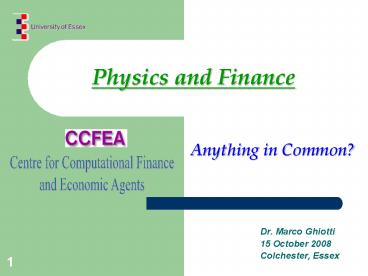Physics and Finance
1 / 16
Title: Physics and Finance
1
Physics and Finance
Anything in Common?
Centre for Computational Finance and Economic
Agents
- Dr. Marco Ghiotti
- 15 October 2008
- Colchester, Essex
2
Key factors in Computational Finance
- Financial markets have proven to be complex and
highly non-trivial - Large use of statistics techniques to study stock
and asset behaviors - Deep understanding of advanced mathematics to
model financial instruments (portfolios and
derivatives) - Analytical ability to design efficient algorithms
3
Brownian Motion
- in 1827 botanist Robert Brown studied pollen
particles floating in water under microscope - in 1905 physicist Albert Einstein and in 1906
statistical physicist Marian Smoluchowski
explained brownian motion of atoms and molecules - Stock fluctuations can be regarded as Brownian
motion
4
How does it look like?
White Noise and Ordinary Brownian motion in N
simulated by summing independent uniform random
variables Reference Heredity (2006) 97,
258268 Nature, 7 November 2005
5
Mathematical Formulation
- The random variable Wt is Brownian if
- W0 0
- Wt almost continuous
- Wt - Ws N(0, t-s) for 0 s t
- Wt1 - Ws1 and Wt2 - Ws2 indipendent for 0 s1
t1 s2 t2
6
Physics interpretation
- A particle in a fluid follows a Brownian motion
if - Viscosity Force
- Isotropy
- No correlation
- Gaussian distribution (central limit)
7
How weirdly stochastic nature is!
Monte Carlo simulations of discretized models of
QCD. Quark plasma under effects of instanton
quantum fluctuations. D.Leinweber et
al Phys.Rev.D64034501,2001 Centre for the
Subatomic Structure of Matter (CSSM), Australia
8
Stochastic Process
- St is the price of an underlying instrument
- where µ is the constant drift term and s is the
volatility. - Wt is the stochastic term.
9
Black-Scholes equation
Under some conditions we get the famous
Black-Scholes equation for a European call option
C to buy at price K
S is the current price of the stock, r is the
continuously-compounded risk-free interest rate,
and s is the constant stock's volatility. It
follows a Geometric Brownian Motion (GBM)
10
Stochastic Processes in Physics
- Mechanical Statistics in atom physics, nuclear
processes and nano technology (semiconductors) - Stochastic Quantization by Parisi-Wu
Sci.Sin.24483,1981. - (quantitative finance with Itos calculus)
- Gauge theories for non-Abelian processes by
Zwanziger (Langevin approach) - Phys.Rev.D67105001,2003.
11
Portfolio Optimization and Physics
- Return distribution by studying minima
- How to select unambiguously extreme points of a
function - Algorithms to identify huge numbers of minima and
locate those which are global - Physics does the same thing
- but
- with different techniques
12
Physics Optimization Techniques an example
This simulation is derived by looking for extreme
points of the path-integral Yang-Mills equation
for Quantum Chromo Dynamics (QCD)
Au are fields, O is a physical observable and SYM
is the Euclidean action M.Ghiotti et
al. Phys.Lett.B628176-182
13
to continue...
- Infinite numbers of minima (equivalence class)
- Mathematical property gauge invariance gives
redundancy of minima - Need to classify equivalence classes
- On the continuum physical condition selects some
fields belonging to eq. classes - On the lattice (discretized space) Monte Carlo
Probability select the right minima
14
Where Physics differs from Finance
- Associate minima to new (unphysical) particles,
called Ghosts - Physics cares about geometry and topology. Minima
are manifestation of Riemannian underlying
geometric structures - Continuum and Discrete models must converge to
some limit otherwise Nature wouldnt exist. - M.Ghiotti et al.
- Phys.Rev.D79054509
15
Optimization with Geometry?
- Is it possible to study portfolio behaviors with
topological geometry? - if so, what is the ghost counterpart of
portfolio minima? - Can we have ghost returns? That would be quite
scary!!!
16
Thank you!
Centre for Computational Finance and Economic
Agents
- Dr. Marco Ghiotti
- 15 October 2008
- Colchester, Essex































